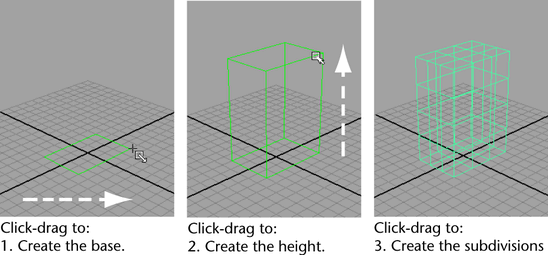You can position, scale, and adjust various attributes on primitives as you create them using the Interactive Creation feature. Interactive Creation is turned on by default.
The Interactive primitive creation feature lets you create primitives in two ways:
 .
. 
The Exit on Completion option (turned on by default) automatically exits the primitive creation tool once you have created the primitive. If you want to create multiple primitives, turn off Create > Polygon Primitives > Exit on Completion.
If you prefer to have primitives created at the origin with options set by Create > Polygon Primitives > Primitive Shape >  , select Create > Polygon Primitives > Interactive Creation to turn off the Interactive Creation feature.
, select Create > Polygon Primitives > Interactive Creation to turn off the Interactive Creation feature.
You can also turn the Interactive Creation feature on and off for polygon primitives from the marking menu by selecting  +
+  .
.
For more information, see Create polygon primitives using the Create menu.
The steps for creating a polygon primitive interactively consist of multiple click-drag operations in the scene view. The number of click-drag operations varies depending on the primitive type:
If you want to skip interactively setting an attribute during the interactive creation process, single-click with your mouse to move to the next step.
If you want to change the non-interactive attributes that a polygon primitive is created with, such as Radius, Divisions,
or Texture Mapping UVs, select Create > Polygon Primitives > Primitive Shape >  .
.
When the primitive creation steps are complete, the wireframe color for the primitive changes from a bright green to the green color for an actively selected object.
Primitives with caps (Pyramid,Cylinder, Cone, Pipe) have an additional attribute called Adjust cap subdivisions after create that is turned off by default. When you turn this feature on in the primitive’s tool options window, an additional step is added to the interactive creation process for those primitive types.
Holding down the Shift and Control keys during primitive creation has the following effect:
To create a polygon primitive with a single click
If you want to change the settings that the polygon primitive is created with, such as Divisions or Texture Mapping, select Create > Polygon Primitives > Primitive Shape >  .
.
There are specific single-click settings for primitive creation.
To create multiple polygon primitives interactively
You can create multiple polygon primitives in succession without having to return to the Polygon Primitive menu or Shelf.
During interactive primitive creation, you can snap the polygon to existing objects in the scene. You have the following options (click the icon in the Status line or press the hotkey). Snap to:
These features let you snap to a projected point on the line or plane defined by any other object in your scene while you create the primitive. For example, you could create a cylinder to act as a telescope on the dome of an observatory.
Instead, create the base of a cube in the perspective view, then switch to a front or side orthographic view to snap the height of the cube using the grid as a reference.
For more information, see Snap to the grid, a curve, points, a view plane, or the center of a geometry and Snapping with live objects.
 Except where otherwise noted, this work is licensed under a Creative Commons Attribution-NonCommercial-ShareAlike 3.0 Unported License
Except where otherwise noted, this work is licensed under a Creative Commons Attribution-NonCommercial-ShareAlike 3.0 Unported License